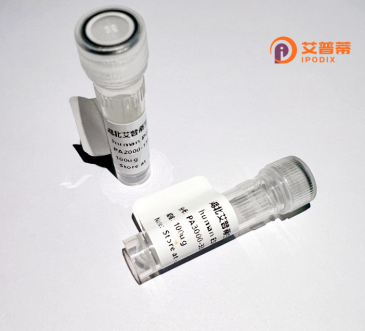
| 纯度 | >90%SDS-PAGE. |
| 种属 | Human |
| 靶点 | GPR3 |
| Uniprot No | P46089 |
| 内毒素 | < 0.01EU/μg |
| 表达宿主 | E.coli |
| 表达区间 | 1-330aa |
| 氨基酸序列 | MMWGAGSPLAWLSAGSGNVNVSSVGPAEGPTGPAAPLPSPKAWDVVLCISGTLVSCENALVVAIIVGTPAFRAPMFLLVGSLAVADLLAGLGLVLHFAAVFCIGSAEMSLVLVGVLAMAFTASIGSLLAITVDRYLSLYNALTYYSETTVTRTYVMLALVWGGALGLGLLPVLAWNCLDGLTTCGVVYPLSKNHLVVLAIAFFMVFGIMLQLYAQICRIVCRHAQQIALQRHLLPASHYVATRKGIATLAVVLGAFAACWLPFTVYCLLGDAHSPPLYTYLTLLPATYNSMINPIIYAFRNQDVQKVLWAVCCCCSSSKIPFRSRSPSDV |
| 分子量 | 62.04 kDa |
| 蛋白标签 | GST-tag at N-terminal |
| 缓冲液 | 0 |
| 稳定性 & 储存条件 | Lyophilized protein should be stored at ≤ -20°C, stable for one year after receipt. Reconstituted protein solution can be stored at 2-8°C for 2-7 days. Aliquots of reconstituted samples are stable at ≤ -20°C for 3 months. |
| 复溶 | Always centrifuge tubes before opening.Do not mix by vortex or pipetting. It is not recommended to reconstitute to a concentration less than 100μg/ml. Dissolve the lyophilized protein in distilled water. Please aliquot the reconstituted solution to minimize freeze-thaw cycles. |
以下是3篇关于重组人GPR3蛋白的关键文献简述:
1. **"GPR3 regulates amyloid-beta production by modulating the activity of the beta-secretase BACE1"**
- 作者:Huang, Y., et al.
- 摘要:研究证明重组人GPR3蛋白通过组成型激活Gs信号通路,升高细胞内cAMP水平,促进β-分泌酶(BACE1)活性,从而增加阿尔茨海默病相关的β-淀粉样蛋白生成。
2. **"Constitutive activity of the G-protein-coupled receptor GPR3 sustains spontaneous germinal vesicle breakdown in mouse oocytes"**
- 作者:Mehlmann, L.M., et al.
- 摘要:通过表达重组人GPR3蛋白,发现其作为组成型活性GPCR维持卵母细胞中cAMP水平,调控自发减数分裂恢复,揭示了GPR3在生殖生物学中的关键作用。
3. **"Targeted disruption of GPR3 leads to altered astrocyte activity and synaptic plasticity"**
- 作者:Borghese, C.M., et al.
- 摘要:利用重组GPR3蛋白研究其在中枢神经系统的功能,发现其缺失导致星形胶质细胞cAMP信号失调,进而影响突触可塑性和认知行为,提示GPR3在神经退行性疾病中的潜在机制。
这些文献涵盖GPR3在神经病理、生殖调控及神经胶质细胞中的作用,均涉及重组蛋白在机制研究中的应用。
Recombinant human GPR3 (rhGPR3) is a synthetically produced version of the G protein-coupled receptor 3. a Class A GPCR implicated in neurotransmission, cellular signaling, and disease pathways. GPR3 is constitutively active, meaning it signals without requiring external ligands, though its endogenous ligands remain poorly characterized. It is highly expressed in the central nervous system, particularly in neurons, and plays roles in maintaining meiotic arrest in oocytes, modulating neurotransmitter release, and regulating β-amyloid production in Alzheimer’s disease models. Structurally, rhGPR3 preserves the seven-transmembrane α-helical domains characteristic of GPCRs, engineered for stability and functionality in vitro. Researchers utilize recombinant GPR3 to study its signaling mechanisms (e.g., cAMP pathways), screen drug candidates targeting neurological disorders, and explore its therapeutic potential in neurodegeneration or fertility regulation. Production typically involves heterologous expression systems (e.g., HEK293 or insect cells), followed by purification via affinity chromatography. Challenges include maintaining receptor conformation and activity post-purification. Current studies focus on elucidating its ligand interactions and pathological roles, positioning rhGPR3 as a critical tool for both basic research and drug discovery.
×